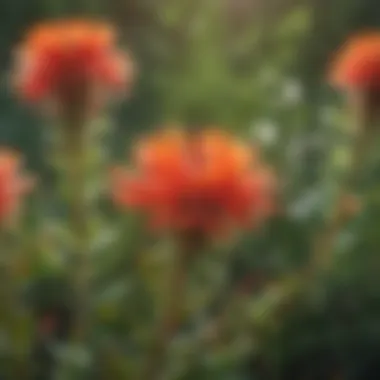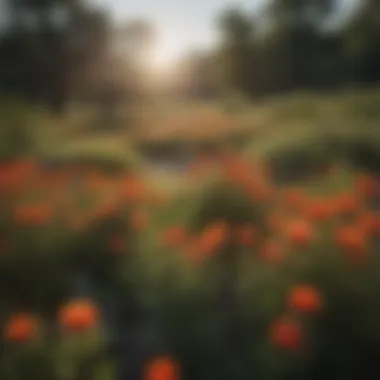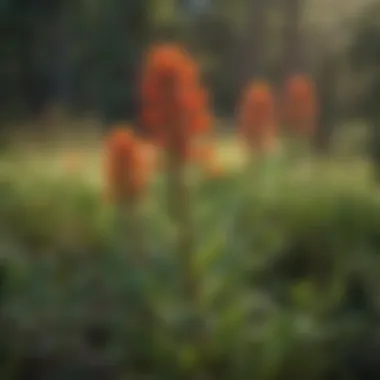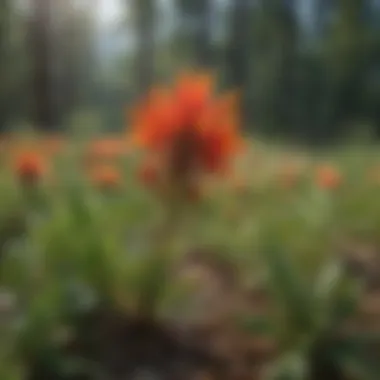Understanding the Indian Paintbrush in Texas


Intro
The Indian Paintbrush is a captivating wildflower that serves as a hallmark of the Texas landscape. Known for its vibrant hues, particularly red and orange, this species (Castilleja spp.) is not only visually striking but also ecologically significant. Understanding its biology and ecology can facilitate better appreciation and conservation efforts.
This article will highlight various aspects of the Indian Paintbrush, including its biological classification, ecological roles, and cultural importance. Furthermore, it will explore the growing conditions required by this flower, its conservation status, and the broader role it plays in Texas ecosystems.
Understanding Forestry Practices
Forestry practices play a crucial role in maintaining the health of ecosystems, including those that support the Indian Paintbrush. Awareness of these practices helps professionals create effective management plans that can aid in conservation efforts.
Types of Forestry Practices
- Sustainable Forestry: This method focuses on balancing economic demands with ecosystem health. It promotes practices that minimize damage to the environment while providing resources.
- Selective Logging: Contrary to clear-cutting, this practice involves only removing certain trees while preserving the surrounding flora. This method can create a habitat conducive to various species, including the Indian Paintbrush.
- Reforestation: Replanting tree species is essential after logging activities. It aids in restoring habitats and supports diverse plant life.
Historical Context
Understanding the history of forestry practices in Texas gives insight into the challenges and successes of conservation efforts. Traditionally, much of Texas faced extensive logging, which led to habitat degradation. Efforts have since shifted to more sustainable practices, largely influenced by environmental movements in the late 20th century. This background is significant as the Indian Paintbrush and other native species rely on healthy ecosystems for survival.
Principles of Woodland Stewardship
For ecosystems to thrive, stewardship practices must be applied. These principles guide land managers and conservationists in maintaining the natural balance.
Conservation Techniques
Conservation techniques can vary but often include the following:
- Controlled Burns: These are used to manage and restore habitats. Fire can stimulate the growth of certain plants, including wildflowers.
- Habitat Restoration: This technique focuses on rehabilitating areas damaged by human activity.
- Wildlife Management: This includes creating habitats that protect various species, which in turn supports the plants they rely on.
Managing Forest Resources
Effective management involves understanding the interconnectedness of species. Foresters must consider the specific needs of the Indian Paintbrush when managing resources. This includes monitoring plant health and combating invasive species that threaten native flora.
Sustainable Forest Management
Sustainable forest management integrates environmental, social, and economic factors. The intention is to meet current needs while preserving resources for future generations.
Certification Standards
There are various certification standards that guide sustainable practices, such as the Forest Stewardship Council (FSC) and the Sustainable Forestry Initiative (SFI). These certifications help ensure that forestry practices meet strict environmental and social standards.
Economic Benefits of Sustainability
Investing in sustainable practices not only aids the environment but also provides economic benefits. Healthier forests can lead to increased tourism and recreation opportunities. Furthermore, maintaining biodiversity can yield long-term agricultural viability through effective pollination and pest control.
“Sustainable practices are not just about saving the environment but also about building economic resilience in local communities.”
In the context of Texas, understanding and applying these principles can significantly benefit both the Indian Paintbrush and the broader ecosystem.
Prelims to Indian Paintbrush


The Indian Paintbrush, a common wildflower in Texas, holds significant ecological and cultural roles. Understanding this flower enriches our appreciation of the biodiversity in Texas. Its vibrant colors not only add beauty to the landscape but also contribute to local ecosystems. This overview focuses on its biology, ecological importance, and cultural significance. Exploring these aspects helps in recognizing the necessity of conservation efforts surrounding this unique species.
Overview of Indian Paintbrush Species
Indian Paintbrush belongs to the genus Castilleja, which is comprised of several species found throughout North America. In Texas, the most prevalent species include Castilleja indivisa, commonly known as the Texas Indian Paintbrush, and Castilleja coccinea. These flowers are characterized by their bright red to orange hues, which can vary based on environmental conditions. They are hemiparasitic plants, meaning they can photosynthesize but also extract nutrients from the roots of neighboring plants. This adaptation allows them to thrive in a variety of soil types, often seen in areas with well-drained sandy soils.
The life cycle of Indian Paintbrush typically begins with germination in the spring. The plant blooms in late spring to early summer, attracting pollinators such as bees and butterflies. However, the prevalence of Indian Paintbrush can be affected by various environmental stressors such as drought or habitat destruction, impacting its growth and distribution.
Historical Context in Texas
The Indian Paintbrush has deep historical roots in Texas, where it was acknowledged by Native American tribes. Indigenous peoples utilized the plant both symbolically and practically. Some tribes regarded it as a representation of the dance of the spirits, believed to color the earth. Furthermore, the leaves have been used in traditional medicine, showcasing the plant's value beyond mere aesthetics.
During the 19th and 20th centuries, the flower became a symbol of Texan pride and heritage. The state's beauty and its wildflowers are often celebrated during the spring, reflecting regional identity. Today, Indian Paintbrush is not only an integral part of the natural ecosystem but also a prominent feature in Texas culture, celebrated during events and festivals related to native flora.
Botanical Characteristics
The botanical characteristics of Indian Paintbrush play a critical role in understanding this unique wildflower. Not only do these features help in identifying the species, but they also highlight how it interacts with its environment. Recognizing these traits could aid in conservation efforts and ensure the species thrives in its native habitat.
Taxonomy and Classification
Indian Paintbrush belongs to the Castilleja genus, which consists of various species found across North America. The classification of this wildflower varies, primarily due to hybridization among its species. The most prevalent ones in Texas include Castilleja indivisa and Castilleja coccinea. These classifications are significant not just for academic purposes, but also for conservationists who focus on preserving specific varieties that may be at risk. The family Orobanchaceae, which includes other wildflowers and plants, often illustrates how Indian Paintbrush fits into a broader ecological context.
Physical Features
The physical features of Indian Paintbrush are striking and serve functional purposes. The flower spikes can grow up to 3 feet tall and exhibit vivid colors ranging from bright red to orange. This coloration is not merely aesthetic; it attracts pollinators such as bees and butterflies, which are vital for the plant's reproductive process. The leaves are narrow and lanceolate, contributing to the overall appearance while adapting to various environmental conditions.
"The vibrant hues of Indian Paintbrush serve as a beacon for pollinators, emphasizing the interconnectedness of flora and fauna in Texas ecosystems."
From a physiological standpoint, Indian Paintbrush is a hemiparasitic plant, meaning it can photosynthesize but also taps into the root systems of nearby plants for water and nutrients. This unique adaptation allows it to thrive in less fertile areas where other plants may struggle.
Recognizing the taxonomy and physical features of Indian Paintbrush enhances our understanding of its ecological role and informs conservation strategies. By acknowledging these botanical characteristics, we can appreciate the intricate relationship this flower maintains with its environment and the various species that rely on it.
Ecological Importance
The ecological significance of the Indian Paintbrush lies in its multifaceted roles within local ecosystems and the broader implications for biodiversity. As a hemiparasitic plant, it engages in complex interactions with other flora, primarily through its root systems. This plant derives some nutrients from its host plants, while still performing photosynthesis. Such relationships promote nutrient cycling in the soil, which is vital for the health of the ecosystem.
Role in Local Ecosystems
The Indian Paintbrush interacts predominantly with grasses and other wildflowers. Its presence can influence the composition of plant communities. By sharing water and nutrients with its host plants, it can improve their growth while simultaneously supporting a range of pollinators like bees and butterflies. This makes it an essential component in sustaining the integrity of Texas grasslands and wildflower meadows.
Additionally, Indian Paintbrush serves as a food source for various species. Some herbivores, including certain birds and insects, rely on its nectar or foliage. This plant thus supports diverse wildlife, contributing to overall ecosystem stability.
Moreover, the striking visual presence of Indian Paintbrush creates patches of vibrant color. This visual appeal is significant for attracting pollinators and guiding them to other flowering plants. The plant’s blooming cycle often synchronizes with that of its environment, ensuring that it plays a role in the timing of ecological interactions.
Contribution to Biodiversity
Indian Paintbrush enhances local biodiversity not only as a host for numerous organisms but also as part of a larger ecological framework. By participating in symbiotic relationships, it supports the survival of various plant species. In doing so, it helps maintain genetic diversity within the ecosystem. The plant's varied forms across different species further enriches the genetic pool of the area.
The presence of Indian Paintbrush in an ecosystem often signals healthy conditions. When conditions are right for it to thrive, one can infer that the broader ecosystem supports various forms of life, illustrating the plant's role as both an indicator and contributor to biodiversity. The native range of this wildflower means it occupies specific niches that many non-native species cannot thrive in, highlighting its importance in preserving local flora.


"Biodiversity is the cornerstone of effective ecosystems, and plants like Indian Paintbrush play a crucial role in maintaining that diversity."
Simultaneously, Indian Paintbrush species can adapt to varying conditions. These adaptations allow them to fit into diverse environments, further indicating their role in fostering resilient ecosystems. Their ability to grow in different habitats makes them a valuable element in ecological restoration efforts.
In summary, the Indian Paintbrush is not just a beautiful flowering plant; it plays vital roles that support and enhance ecosystems in Texas. Through its interactions with other plants and wildlife, it facilitates nutrient cycling, promotes biodiversity, and contributes to the overall health of its habitat.
Cultivation and Growing Conditions
Understanding the cultivation and growing conditions of the Indian Paintbrush is essential for those interested in preserving this species and contributing to its ecosystem. The Indian Paintbrush thrives in specific environments, making knowledge of optimal growing conditions critical for successful cultivation. Factors such as soil type, climate, and water availability play significant roles in ensuring healthy plant growth. By recognizing these conditions, gardeners and conservationists can effectively contribute to the survival of this beautiful wildflower.
Optimal Growth Environments
Indian Paintbrush generally prefers well-drained soils. Sandy loam or rocky soils are favorable since they mimic the plant's natural habitats. Proper drainage helps prevent root rot, which can be fatal to the plant. Additionally, the species flourishes in areas that receive plenty of sunlight. Ideally, the plant needs full sun exposure for at least six hours per day.
Soil pH also matters; slightly acidic to neutral pH levels are best. The average temperature range suitable for Indian Paintbrush varies through the seasons but generally lies between 75°F to 90°F during peak growth. Areas with mild winters and moderate rainfall create a conducive environment for germination and establishment. Understanding these factors significantly increases the chance of a vibrant Indian Paintbrush population.
Propagation Techniques
Propagating Indian Paintbrush can be performed through seed sowing or transplanting seedlings. The seeds are best sown in the fall. This timing allows them to experience natural cold stratification, which aids in germination. It’s essential to plant seeds at a depth of about one-quarter inch, with spacing that allows for adequate sunlight and air circulation.
For those interested in transplanting, seedlings should be grown in a controlled environment before moving them to their permanent locations. Using peat pots can minimize transplant shock. During the seedling stage, sufficient watering is crucial, but care must be taken against over-watering—roots require oxygen as much as they need water.
Common Growing Mistakes
Several challenges can arise during cultivation, particularly for those new to growing Indian Paintbrush. One common mistake is planting in heavy clay soils, which inhibit proper root development. Another frequent error involves inadequate sunlight; without sufficient exposure, the plants may grow weak and leggy.
Over-fertilization is also problematic as it can lead to excessive foliage growth at the expense of flowers. Furthermore, failure to mimic the plant’s native environment can result in poor health or even death.
A crucial point to remember is that Indian Paintbrush is a hemiparasitic plant. It relies on certain host plants, particularly grasses, for nutrients. Ignoring the need for companion plants can lead to unsuccessful growth and vitality of the Indian Paintbrush.
Proper cultivation entails understanding the nuanced needs of Indian Paintbrush, ensuring better outcomes for both the plant and its surrounding ecosystem.
By emphasizing the specific requirements for cultivation and recognizing the common pitfalls, gardeners and conservationists can foster a flourishing community of Indian Paintbrush in Texas.
Conservation Status
The conservation status of the Indian Paintbrush is critical in ensuring its survival and the overall health of Texas ecosystems. This wildflower, known for its vibrant colors and unique appearance, faces various challenges that threaten its existence. Understanding these threats and the efforts made to conserve this species is vital for both ecological balance and cultural preservation.
Threats to Indian Paintbrush
Identifying the various threats to the Indian Paintbrush reveals the complexities of its conservation. Here are some significant risks:
- Habitat Loss: Urban development, agriculture, and land clearing for other purposes frequently disrupt natural habitats where Indian Paintbrush grows.
- Invasive Species: Non-native plants and animals often compete for resources, which can lead to declining populations of Indian Paintbrush.
- Climate Change: Shifting climate patterns affect rainfall and temperature, which can change the growth conditions required for the species to thrive.
- Pollution: Air and soil pollution can directly impact plant health, affecting their reproduction and lifespan.
The combination of these factors creates a precarious situation for the Indian Paintbrush. Without targeted strategies, it risks declining to levels where it may become endangered.
Conservation Efforts
Efforts to conserve the Indian Paintbrush are multi-faceted, encompassing education, restoration, and protection strategies. Here are some initiatives currently in place:


- Public Awareness Campaigns: Educating the public about the value of the Indian Paintbrush through workshops, online resources, and outreach can inspire community involvement in conservation efforts.
- Restoration Projects: Organizations have begun habitat restoration projects in areas where Indian Paintbrush populations have dwindled. This includes reintroducing native plants and creating buffer zones to protect existing habitats.
- Research and Monitoring: Ongoing studies focus on evaluating the health of Indian Paintbrush populations. This research helps identify the most effective conservation strategies moving forward.
- Legislation and Policies: Local and state governments are working to enact regulations that protect native flora, including the Indian Paintbrush, from habitat destruction and overexploitation.
“Conservation efforts play a key role in protecting the delicate balance of our ecosystems and preserving species such as the Indian Paintbrush.”
These combined efforts are essential to ensure that the Indian Paintbrush not only survives but thrives in Texas's diverse landscapes. Monitoring ongoing threats and adapting strategies accordingly will remain paramount in the years to come.
Cultural and Historical Relevance
The Indian Paintbrush holds both cultural and historical significance in Texas. This wildflower captures the attention of ecologists, historians, and cultural scholars alike. Its presence across the Texas landscape provides a direct connection to the heritage and traditions of Native American tribes. This relationship underscores the broader context of how flora can influence cultural practices and identities.
Significance in Native American Culture
For many Native American tribes, Indian Paintbrush is more than just a flower. It symbolizes beauty and resilience. Tribes such as the Comanche and Apache have long recognized the plant's importance. It often features in traditional ceremonies and serves as a source for natural dyes. The vibrant colors of Indian Paintbrush are believed to hold spiritual significance. Some legends mention that the plant emerged from the tears of a grieving woman, adding depth to its role in storytelling and cultural expressions. Understanding this connection enriches our appreciation of the plant beyond its biological aspects, viewing it as a vital cultural artifact.
Symbolism and Folklore
The symbolism associated with Indian Paintbrush extends into various folklore and traditions. Many stories emphasize the flower's role in marking seasonal changes and its association with healing. For example, in some narratives, Indian Paintbrush is thought to have medicinal properties. This viewpoint aligns with broader indigenous practices of using local flora for health and wellness.
Moreover, Indian Paintbrush often appears in artworks and crafts, showcasing its aesthetic value. Today, its imagery serves as a potent reminder of the Texas landscape's natural beauty and cultural heritage. Incorporating these symbolic elements into modern conservation efforts emphasizes the need to preserve both the plant and the cultural narratives surrounding it.
"The Indian Paintbrush is a bridge between nature and culture, illustrating the indispensable bond that communities share with their environment."
In summary, the cultural and historical relevance of the Indian Paintbrush deepens our understanding of this wildflower in Texas. It underscores not only the ecological importance but also the narratives that have shaped human and natural connections over generations.
Research and Studies
Research into the Indian Paintbrush is crucial for several reasons. First, understanding its biology allows scientists to appreciate its role in the ecosystem. Second, studies serve to identify the challenges it faces, guiding conservation efforts. Additionally, research can reveal how this wildflower interacts with various species, contributing to broader ecological knowledge. Ultimately, advancing our understanding ensures informed actions towards its preservation.
Recent Findings
Recent studies have shed light on various aspects of Indian Paintbrush. One significant area of focus is its unique symbiotic relationship with certain grasses. Researchers found that the Indian Paintbrush relies on specific host plants for nutrients, highlighting its dependence on a delicate ecological balance. Furthermore, genetic studies revealed that populations vary significantly across Texas regions, indicating that local adaptations might play a role in its survival.
In addition, environmental changes have been scrutinized. A 2022 study noted that increasing urban development is encroaching upon native habitats. This research is vital for developing conservation strategies that align with urban planning efforts. It shows that urban areas can coexist with natural flora if planned wisely.
Future Research Directions
Looking ahead, several research directions are vital for deepening our understanding of the Indian Paintbrush. One potential focus area is the impact of climate change on its growth and distribution. With shifting weather patterns, assessing how temperatures and rainfall affect Indian Paintbrush could help predict future viability.
Another area for exploration is the interaction between Indian Paintbrush and pollinators. As pollinator populations decline globally, understanding how this affects the reproduction of Indian Paintbrush is critical. Furthermore, studies on propagation techniques can provide insights into effective cultivation strategies, which may assist in habitat restoration efforts. Establishing more native populations in non-native areas could be beneficial for both the plant and local ecosystems.
"Research is not just about academics; it shapes the very landscape in which we live and grow."
Closure
The conclusion section of this article underscores the vital need to recognize the Indian Paintbrush's role within the Texan landscape. This unique wildflower is not just a beautiful addition to the natural scenery; it embodies significant ecological, cultural, and conservation concerns that warrant attention.
Recap of Key Points
- Botanical Significance: The Indian Paintbrush is a remarkable species with distinctive characteristics that reflect its adaptation to Texas’s diverse environments.
- Ecological Role: It contributes crucially to local ecosystems by supporting a variety of wildlife and enhancing biodiversity.
- Cultural Value: Its importance in Native American culture highlights the intertwined relationship between the natural world and human societies.
- Conservation Status: Awareness of threats faced by this plant underscores the urgency for effective conservation strategies.
Overall, the Indian Paintbrush serves as a reminder of the intricate connections within ecosystems and the importance of preserving them for future generations.
Call to Action for Conservation
It is imperative that individuals and organizations work together to protect the Indian Paintbrush and its habitat. Conservation efforts can include:
- Supporting Local Conservation Projects: Engaging in or funding initiatives that aim to restore and protect native habitats.
- Educating Others: Spreading awareness about the significance of this plant within local ecosystems can foster a greater appreciation and push for conservation measures.
- Promoting Sustainable Practices: Adopting gardening and landscaping techniques that prioritize native flora can contribute to the preservation of the Indian Paintbrush.







